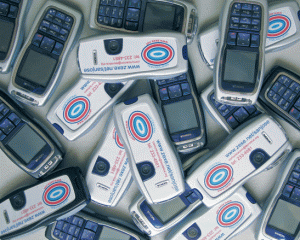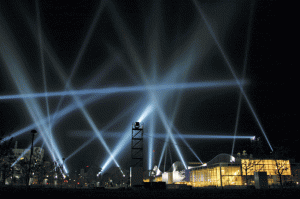« Features
Mobile Art: New Possibilities for Experimentation

Christa Sommerer & Laurent Mignonneau, Mobile Feelings, 2002-03, in collaboration with France Telecom Studio Créatif, Paris. Copyright of the artists.
So-called mobile art has forcefully entered into the field of media art. Over the past decade its potential as a creative tool has manifested itself in hundreds of projects, exhibitions, fairs and workshops. Is mobile art a new means of exploring and reflecting on our relationship to technology? Does mobile art allow for the experimentation and interaction that many digital art projects demand?
By Lorea Iglesias
From the home to the artistic exhibition space is the path that has been followed by some technological communications devices. It happened with radio, television, video and now with the mobile telephone.
Mobile telephone technology has become increasingly evident in society owing to its portability, its ability to unite different technologies, its extensive foothold in society and its power as a medium of alternative registry. All of these characteristics have assisted in the cell phone becoming a tool, medium and perfect support for experimentation by many media artists, although its utilization by creators manifests itself in many different forms from its use as an interactive tool, passing through a critical analysis of the social changes it has provoked in society, to pure fascination with the technological object or the new functions that mobile telephony is developing and incorporating.
HISTORIC ANTECEDENTS
In actuality the mobile phone is much more than a telephone; it is a multifunctional platform that we not only utilize to communicate with other people, but that also accompanies us in such everyday functions as waking up, photographing a friend, watching a video or noting an appointment on an agenda. Now that we are also able to access the Internet these tasks have multiplied and, thanks to Augmented Reality, we even have the possibility of obtaining information beyond what we are able see in our surroundings. However, since its origins are inevitably tied to telephony, we direct ourselves to previous artistic uses of the telephone when looking for the creative antecedents of mobile art. In looking back almost a century in the history of art, we see that the telephone was used artistically for the first time in 1922, the year in which László Moholy-Nagy dictated the instructions (coordinates) of a drawing that he had designed on graph paper over the telephone with the absolute intention of separating the manual task from the intellectual task, thus converting the work into pure information. A few years later, Salvador Dalí was seduced by this communications device and created the typically surrealist sculpture Teléfono Langosta (Lobster Telephone). However, various decades would pass before artists would begin utilizing the telephone in their creations as a vehicle for reflecting on the influence that mass media was exercising on society, reflections presented in a context influenced by the theories of Mcluhan1, one of the founders of media studies and still considered a visionary who anticipated the effects that electronic means of communication would have on society. A notable example is Minuphone, a happening that the Argentine artist Marta Minujin carried out in 1967 and during which people interacted with an electronic cabin in order to feel a “greater awareness of themselves in relation to the always impersonal technology” as the artist herself noted. In 1969 a very significant event took place; the Museum of Contemporary Art Chicago, revisiting the idea of Moholy-Nagy, organized the exhibition “Art By Telephone” in which contemporary conceptual artists, such as Oldenburg, Baldessari or Bruce Nauman among others, called the museum in order to give the instructions necessary to create their works, so that the telephone became the perfect tool to demonstrate that an intellectual approach to the creation of a work of art is in no way inferior to an emotional one.

Nicaraguan migrants webcast from cell phones in San Jose, Costa Rica (2006). Since 2003, the megafone.net project created by Antoni Abad, has been inviting groups of people on the fringe of society to express their experiences and opinions through face-to-face meetings and mobile phones. Courtesy of the artist.
These are just a few examples of works that utilized the telephone throughout the history of art, but its impact cannot be compared to the impact television or video had on art since there were no common strategies or forms and thus it was never recognized as a specific practice, something very different from what occurs today with the use of the mobile phone. The numerous projects that have been carried out over the past decade are a clear indication of the enormous potential of the mobile phone as a tool of creativity and experimentation in media art. Its tremendous technological advancement has caused it to become a key ingredient in interactive projects in which users can encounter new experiences utilizing a tool so familiar and common to all of us. In fact, the acceptance being given to the mobile phone by artists and society as a whole is key to understanding how mobile art is taking shape as a discipline within digital creation.
MOBILE ART WITHIN DIGITAL CREATION
Over the past decade we witnessed how digital creators were taking advantage of the artistic potential of very different forms of mobile communication, but many of the first projects we encountered focused on an analysis of and reflection on how this type of communication affected our personal relationships, our privacy, or method of comportment and in general the social changes it entailed. Antoni Muntadas2 with his piece On Traslation: Il Telefonino (2001) was one of the first to cause us to reflect on the new dimension that was being established between public and private space from the generalized use of the mobile phone through a series of photographs that explored the unconscious mechanisms generated by an apparently private communications process that becomes a public act as a result of where it takes place. In this same vein, but using and adapting the mobile phone differently, Christa Sommerer and Laurent Mignonneau presented the piece Mobile Feelings at the 2003 Festival Ars Electrónica. Starting with a reflection on how technology has transformed our social and individual lives and how we accept reduced privacy in exchange for mobility, they transformed mobile telephone circuits to create a device that would enable more sensorial communication including smell, sweat, respiration or heartbeats.

Rafael Lozano-Hemmer, Amodal Suspension, Interactive installation Yamaguchi Center for the Art and Media, Japan, 2003. Courtesy of the artist.
From a much more spectacular perspective, many media artists see in this wireless communication device the perfect tool for interaction within the public realm. There are a great many interactive projects in which users transform public space through the use of technology, and the mobile phone has become a valuable interface for these types of actions since it offers the user a lot of autonomy and furthermore he is totally accustomed to using it. A clear and early example of this is Rafael Lozano-Hemmer’s Amodal Suspension (2003) in which, through the use of the mobile phone and the Internet, he is surprisingly able to combine architecture, public space, technology and participation. The public was to send text messages with their mobile phones and these were codified into lights, which were first projected in the sky and then converted back into their original format, so that they could be projected on the façade of a building thereby considerably altering the urban landscape.
NEW SOCIAL AND ARTISTIC RELATIONSHIPS
Today technology fosters new social relationships and opens new paths and artistic possibilities, allowing some creations to be converted into platforms that assist in our development and make it possible for us to freely express ourselves outside of conventional circuits, as is the case with megafone.net (see http://www.megafone.net/) (2004-2010). For more than six years, the artist Antoni Abad has been working with collectives at risk for social exclusion and misrepresented by the mass media, providing them with mobile phones so that they can publish their own experiences, through geolocalized photos, text and sounds that are automatically published on the Web, thus turning the mobile phone into a megaphone that gives voice to these digital communities and allows them to represent themselves. Mexico City, Barcelona, Sao Paulo and Geneva are just a few of the cities in which different versions of this project have been developed as it continues to grow, bringing art within reach of society.
This has been a brief summary of the very diverse ways in which creators are currently using the mobile phone. In order to get a more complete idea, one should discuss geolocalized rundowns by cities, musical creations and concerts, artistic applications for the iPhone or Android, or the vast audiovisual creations that mobile phones favor. The latter are making an appearance in renowned international competitions as was the case with Mankind Is No Island 3, a delicious short filmed exclusively with a mobile phone and which surprisingly won the prestigious “TropfestNY 08.”
Taking into account the unstoppable technological advances existing in the field of mobile communication and the new functionalities being added to computer terminals, one can easily imagine that artistic practices associated with this technology will continue to multiply. The mobile phone continually provides digital artists with more possibilities for experimentation and will place at our disposal levels of interaction that we can presently barely imagine.
The great challenge will be to analyze and organize the huge quantity of information that is being generated in these practices. In doing this, we will be able to assess the role that mobile communication technology is playing within the realm of electronic and digital art as well as the history of art in general.
NOTES
1 See: Marshall Mcluhan, Understanding Media: The Extensions of Man. New York: McGraw Hill, 1964.
2 On Translation http://www.adaweb.com/influx/muntadas/
3 See: Mankind Is no Island short film by Jason Van Genderen http://vimeo.com/1967131
Lorea Iglesias is researching the use of mobile phones in artistic practices at the Universitat Autònoma de Barcelona. She has a degree in Art History and specialized in Museology, and she also has a master’s degree in Curatorship of New Media Art. She is currently the coordinator of the Movil Film Fest and the creator and writer of Mobile Art Blog.


































